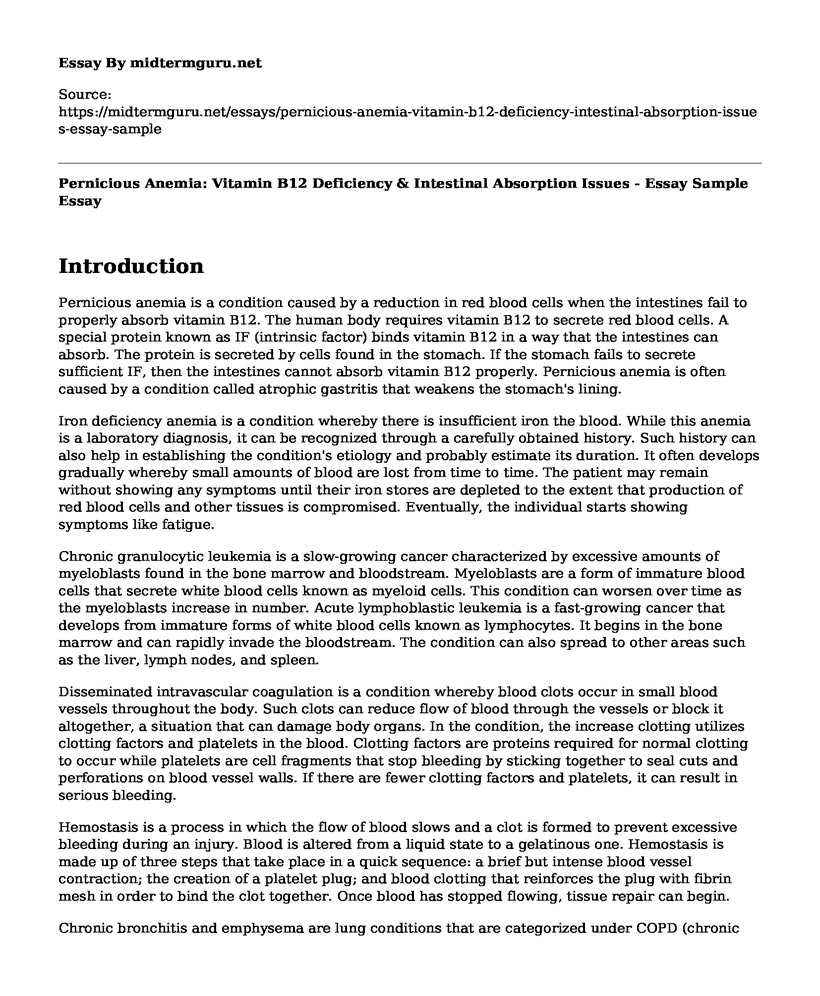Introduction
Pernicious anemia is a condition caused by a reduction in red blood cells when the intestines fail to properly absorb vitamin B12. The human body requires vitamin B12 to secrete red blood cells. A special protein known as IF (intrinsic factor) binds vitamin B12 in a way that the intestines can absorb. The protein is secreted by cells found in the stomach. If the stomach fails to secrete sufficient IF, then the intestines cannot absorb vitamin B12 properly. Pernicious anemia is often caused by a condition called atrophic gastritis that weakens the stomach's lining.
Iron deficiency anemia is a condition whereby there is insufficient iron the blood. While this anemia is a laboratory diagnosis, it can be recognized through a carefully obtained history. Such history can also help in establishing the condition's etiology and probably estimate its duration. It often develops gradually whereby small amounts of blood are lost from time to time. The patient may remain without showing any symptoms until their iron stores are depleted to the extent that production of red blood cells and other tissues is compromised. Eventually, the individual starts showing symptoms like fatigue.
Chronic granulocytic leukemia is a slow-growing cancer characterized by excessive amounts of myeloblasts found in the bone marrow and bloodstream. Myeloblasts are a form of immature blood cells that secrete white blood cells known as myeloid cells. This condition can worsen over time as the myeloblasts increase in number. Acute lymphoblastic leukemia is a fast-growing cancer that develops from immature forms of white blood cells known as lymphocytes. It begins in the bone marrow and can rapidly invade the bloodstream. The condition can also spread to other areas such as the liver, lymph nodes, and spleen.
Disseminated intravascular coagulation is a condition whereby blood clots occur in small blood vessels throughout the body. Such clots can reduce flow of blood through the vessels or block it altogether, a situation that can damage body organs. In the condition, the increase clotting utilizes clotting factors and platelets in the blood. Clotting factors are proteins required for normal clotting to occur while platelets are cell fragments that stop bleeding by sticking together to seal cuts and perforations on blood vessel walls. If there are fewer clotting factors and platelets, it can result in serious bleeding.
Hemostasis is a process in which the flow of blood slows and a clot is formed to prevent excessive bleeding during an injury. Blood is altered from a liquid state to a gelatinous one. Hemostasis is made up of three steps that take place in a quick sequence: a brief but intense blood vessel contraction; the creation of a platelet plug; and blood clotting that reinforces the plug with fibrin mesh in order to bind the clot together. Once blood has stopped flowing, tissue repair can begin.
Chronic bronchitis and emphysema are lung conditions that are categorized under COPD (chronic obstructive pulmonary disease). In emphysema, the air sacs are damaged in such a way that less oxygen enters the blood. Chronic bronchitis destroys cilia in the lungs' airways, making breathing difficult. The two conditions occur together, with both making breathing difficult and sharing symptoms like wheezing, shortness of breath, coughing, and heart issues. The main difference occurs in that chronic bronchitis is characterized by a frequent cough accompanied by mucus, while shortness of breath is the top symptom of emphysema.
References
Boral, B. M., Williams, D. J., & Boral, L. I. (2016). Disseminated intravascular coagulation. American journal of clinical pathology, 146(6), 670-680.
Buontempo, F., McCubrey, J. A., Orsini, E., Ruzzene, M., Cappellini, A., Lonetti, A., ... & Martelli, A. M. (2018). Therapeutic targeting of CK2 in acute and chronic leukemias. Leukemia, 32(1), 1.
Froessler, B., Gajic, T., Dekker, G., & Hodyl, N. A. (2018). Treatment of iron deficiency and iron deficiency anemia with intravenous ferric carboxymaltose in pregnancy. Archives of gynecology and obstetrics, 298(1), 75-82.
McCarthy, B., Casey, D., Devane, D., Murphy, K., Murphy, E., & Lacasse, Y. (2015). Pulmonary rehabilitation for chronic obstructive pulmonary disease. Cochrane database of systematic reviews, (2).
Palm, E., & Inaba, K. (2018). Transfusion, Hemostasis, and Coagulation. Surgical Critical Care and Emergency Surgery: Clinical Questions and Answers, 109-119.
Toh, B. H. (2017). Pathophysiology and laboratory diagnosis of pernicious anemia. Immunologic research, 65(1), 326-330.
Cite this page
Pernicious Anemia: Vitamin B12 Deficiency & Intestinal Absorption Issues - Essay Sample. (2023, Feb 07). Retrieved from https://midtermguru.com/essays/pernicious-anemia-vitamin-b12-deficiency-intestinal-absorption-issues-essay-sample
If you are the original author of this essay and no longer wish to have it published on the midtermguru.com website, please click below to request its removal:
- Reduction of Obesity - Paper Example
- Roles of a Community Health Worker - Paper Example
- Essay on the Issue of Abortion
- A Nurses Eye-View on Health Literacy in Older Adults - Paper Example
- Personal Reflection Paper for Nutrition
- The Crossroads Center - Essay Sample
- Essay Sample on Life in Wheels: Stephany's Story







